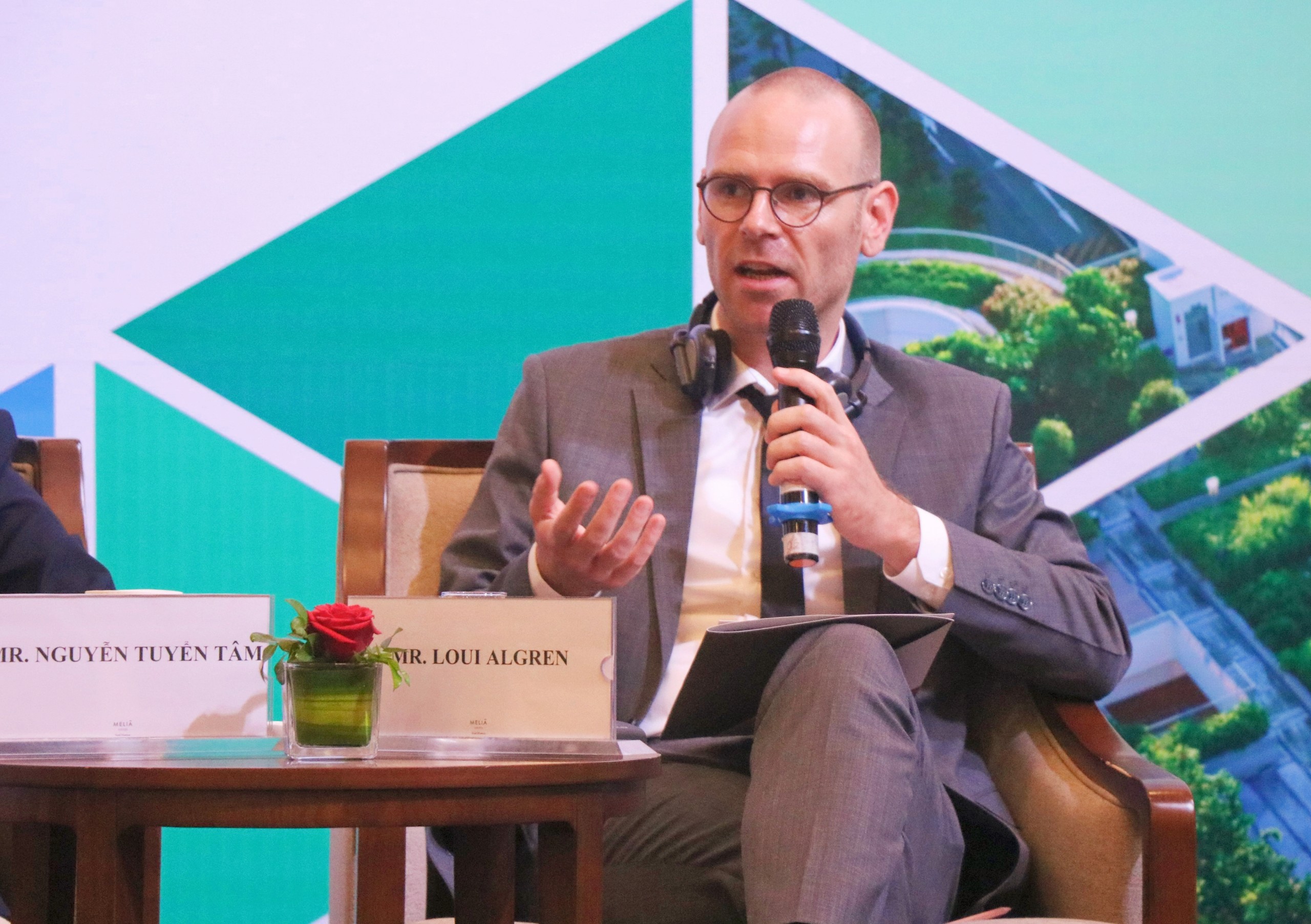The green energy transition is becoming one of the top concerns more than ever since energy is essential for society’s activities. Moreover, under the pressure of climate change, a green transition is considered as the sole way to sustainability.
However, renewable energy is unstable, only effective in a particular time, and high cost. Its “irritating” feature sows doubt in the public about the investment effectiveness of renewable energy.
Denmark is one of the leading countries in renewable energy development, especially offshore wind. In Denmark, 67% of the energy comes from renewable energy, almost 50% of electricity from wind power (according to DEA). Since 2013, Denmark and Vietnam have established a Comprehensive Partnership. Since then, Denmark has provided great support to Vietnam in transiting the energy sector towards clean and low-carbon development.
In this article, Mr. Loui Algren, Long-term Advisor of the Denmark-Vietnam Energy Partnership Program (DEPP), shared his ideas about the most profound lessons from Denmark, how they can be applied in Vietnam, as well as some DEPP's activities to assist the green process of Vietnam.
Mr. Loui Algren, Energy Consultant of the Denmark-Vietnam Energy Partnership Program. Image: DEPP.
Is renewable energy “reliable” to invest in?
Responding to the reporter's question about skeptics' doubts about the effectiveness of renewable energy investment due to its uncertainty, Mr. Loui agreed that it is quite an “challenging feature”. Because of this reason, renewable energy has not been harnessed to its maximized capacity in the last few years. However, he thinks this factor could be overcome very soon when forecasting capacity is improved and with the support of advanced tools.
Regarding the investment cost, the Danish expert commented that this factor has been solved gradually due to the technology improvement and other factors. To illustrate this idea, he mentioned that the cost of renewable energy sources, in general, has remarkably reduced in the short term, such as solar power and onshore wind power.
Besides, as renewable energy is abundant, it can significantly contribute to the increasing energy demand for economic development. It is extremely important in the context of conventional energy sources dying out and the supply chain disruption. “The Energy Outlook Report shows that even without carbon tax or emissions reduction targets, renewable energy sources, such as large-scale solar, should at least double by 2030 from a cost-efficiency perspective. Definitely, the cost will decrease and investment efficiency will increase,” he said.
About the target of reaching 7-8GW of offshore wind by 2030 in the draft Power Master Plan 8, he commented, “It is ambitious, but not impossible.”
Compared with onshore wind power, offshore wind power’s advantages are stable productivity and excellent potential. He said that it is necessary to immediately develop incentive schemes and simplify unnecessary procedures to reduce businesses' time and cost burden.
From Danish experiences, it takes about eight years to prepare an offshore wind project, from the auction process, environmental assessment, construction, try-all operation, to connecting to the grid. Hence, procedure-related decisions need to be made quickly to meet the goals.
Renewable energy contributes around 67% of the power supply in Denmark, wind power accounted for more than 50%. Image: DEA.
Experiences from Denmark to Vietnam
The advent of the renewable energy industry in Denmark was about 50 years ago. Currently, offshore wind power accounts for nearly 50% of the country's electricity supply. To reach the current leading position in the field, Denmark has carried out a lot of research, training, testing, especially technologies related to wind turbines.
Vietnam can take advantage of these experiences to develop the offshore wind power industry in particular or renewable power in general. The role of human resources is essential to mastering the technologies and ensuring sustainable development of the industry.
In terms of the market, Danish experience showed that building a fair play that encourages any potential suppliers to participate is crucial for a competitive wholesale electricity market. This will help reduce energy costs and also determine the system’s performance.
Another factor contributing to the development of the industry is the ancillary services. According to the experience from Denmark, a mature ancillary market will significantly save the cost of providing energy services in general. In the Vietnamese electricity market, services are only available in some niches, and the demands are enormous in the whole market.
Another lesson from Denmark is the transition from feed-in-tariff (FIT) scheme to competitive auction scheme. Applying auctions has significantly increased the cost-effectiveness of renewable energy projects. However, there should be careful consideration in transforming the mechanism. As Mr. Loui mentioned, even in Denmark's mature offshore wind market, the procurement is constantly being adjusted to be more cost-effective. Vietnam can also learn a lot from this process.
He also noted that the latest offshore wind auction in Denmark in 2021, resulted in a zero or actually slightly negative bid which means that the winning contractor will not receive any subsidy but actually have to pay a small subsidy to the government. This milestone demonstrates offshore wind’s competitiveness in Denmark and the world market in the near future.
Preparation for a competitive wholesale electricity market
Vietnam has already launched a competitive wholesale electricity market (VWEM). But there are many things needed to be prepared for this.
Two critical technical factors mentioned are accurate prediction ability and transmission capacity.
The Vietnam power transmission system runs longitudinally along the coast. Renewable energy is mainly concentrated in the Center and the South, while the demand in the North is relatively high. Therefore, it is required to improve inter-regional power transmission capacity to share excess volume and ensure the whole system's safety, stability, and economic efficiency. High voltage direct current (HVDC) transmission lines are mentioned as an adequate solution.
Mr. Loui shared that within the framework of the DEPP, Denmark works closely with Vietnamese partners to improve forecasting capacity and operating skills to adapt to new requirements of operating a smart transmission system of a competitive electricity market.
An incentive scheme boosting a flexible wholesale market is also mentioned. Those are for supporting the whole system's balance when the supply ramps up and down, and simultaneously optimizes the sources as much as possible.
Other market drivers
Besides, the ancillary services market will also contribute to stabilizing the renewable energy market. According to the experiences of the EU and the US, incentive schemes are needed to encourage suppliers to actively participate in the market at the first stage.
Last but not least, when the FIT scheme has expired, there should be an alternative incentive mechanism to continue stimulating various generations. Developing the mechanism requires dialogue involving different stakeholders, especially enterprises. It minimizes risks for investors, which results in reducing energy costs for everyone, for example, compensating for curtailment or providing guaranteed loans.
Danish experts works closely with Vietnamese partners to support capacity building. Image: Lauching of EOR21, an activity under DEPP.
Capacity building of the power system
The Danish expert highlighted the fundamental role of the transmission in the green transition. Expanding and reinforcing the transmission system would ensure the renewable energy supply in the South is transmitted to concentrated industrial parks in the North, like Hanoi and Hai Phong. Another measure is to build up some renewable energy centers near those high-consumed places. However, renewable resources in the North, wind and solar power, for instance, are not as good as in the South. Hence, the first solution is more cost-effective.
Instead of the known AC technology, HVDC lines could be added to the transmission system. According to Mr. Loui, HVDC system operation requires different skills than the alternating current (AC) system. The HVDC’s advantages are to control the exact transmission volume, stabilize the voltage and reactive power through inverters, and other technical aspects. “It brings more benefits”, Mr. Loui affirmed. Currently, Danish experts work closely with the National Load Dispatch Center (AO) to organize training and workshops to help build AO staffs’ capacity on forecasting, dynamic simulations of the grid, and outage planning.
The Danish expert also mentioned that the advanced modeling used to design different energy development scenarios introduced in EOR21 allows close-reality results. The purpose is to understand the optimized expansion of the power system and cost-effective methods toward the net-zero target.
Giang Nguyen - Hoang Loan

.jpg)
.jpg)








 Webinar 2: “Financial Support for Energy Efficiency Enterprises – Opportunities and Challenges”
Webinar 2: “Financial Support for Energy Efficiency Enterprises – Opportunities and Challenges”
 Vietnamese enterprises achieve green growth and cut costs through energy efficiency
Vietnamese enterprises achieve green growth and cut costs through energy efficiency
 Capacity Building for Program Implementing Entity
Capacity Building for Program Implementing Entity
 Enhance Energy Efficiency Knowledge for Managers of Cement Industrial Enterprises
Enhance Energy Efficiency Knowledge for Managers of Cement Industrial Enterprises
 Promoting Energy Efficiency for Technical Staff of Brick and Ceramic Sector
Promoting Energy Efficiency for Technical Staff of Brick and Ceramic Sector
 Capacity building for participating financial institutions of the VSUEE Project
Capacity building for participating financial institutions of the VSUEE Project
 Capacity building for participating financial institutions in Ho Chi Minh City
Capacity building for participating financial institutions in Ho Chi Minh City